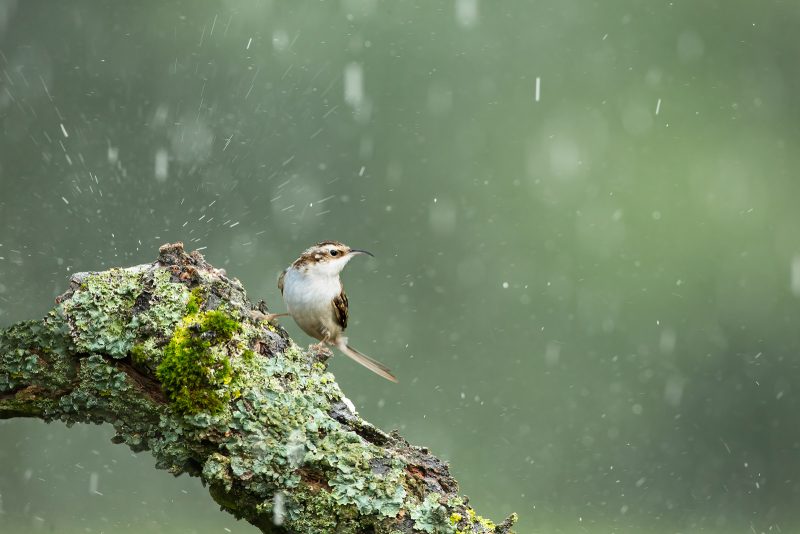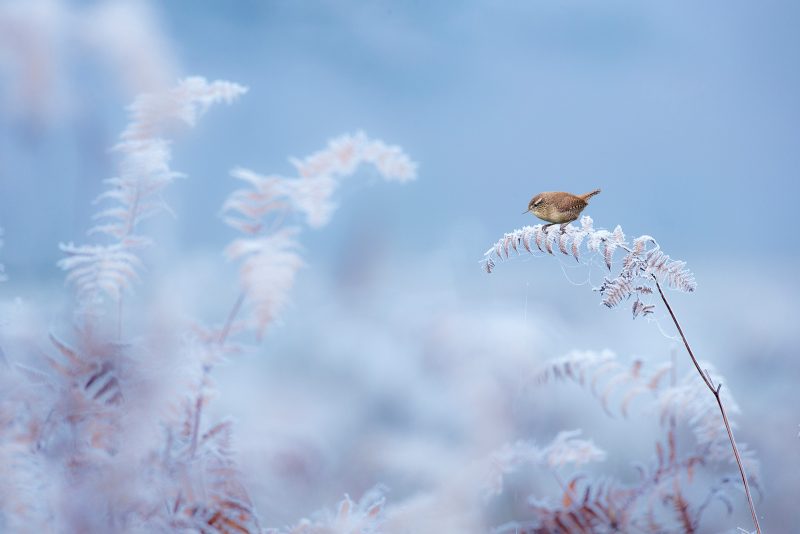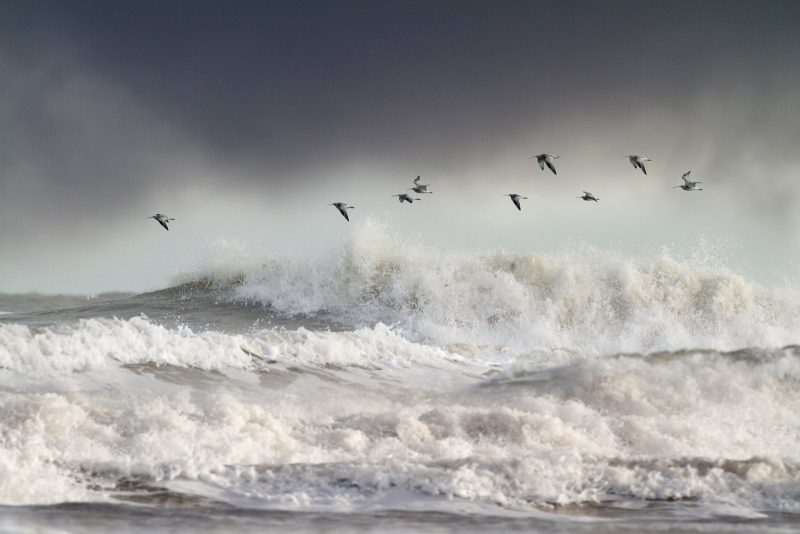How to Photograph Wildlife in Extreme Weather

Photographing wildlife in adverse weather conditions can be a challenge. However, once you overcome the potential problems regarding equipment, and your own comfort levels, you will find that weather can be used to evoke a special kind of atmosphere.
In fact, many of my favourite wildlife images have been taken in extreme weather. From blizzards to torrential rain, and high winds to stormy seas, there is no doubt that ‘bad’ weather can conjure a true sense of the wild and help to take your work to the next level.


Rain
As we progress through spring, the weather can become unsettled and very changeable. During periods of heavy rainfall, most people avoid venturing out, and instead opt for the warm comforts of the indoors.
Embrace the wet weather, however, and you will find opportunities to capture your subject against a backdrop of falling rain. In fact, rain can look wonderfully effective, adding atmosphere and providing a heightened sense of the subject’s environment.
It can be difficult to show rain clearly, as often you’ll find that the rain droplets will blend into the background and become almost invisible. To prevent this from happening, search for darker areas to shoot towards, such as an area of shadow, and don’t be afraid to change your position to find the optimum angle.
Don’t be afraid either to experiment with shutter speeds for some variety. A fast shutter speed will freeze the raindrops, whilst a slower shutter speed will render the rain as long streaks.
Of course, you should only attempt to use a slow shutter speed if your subject is motionless, and you have a sturdy camera support in place, such as a tripod or beanbag, to stop unwanted blur. Slow shutter speeds can work particularly well against dark backgrounds where the rain is more visible.
It is also worth keeping an eye out for smaller details, such as raindrops clinging to a bird’s plumage. I always make a point of taking a macro lens out with me, should such an opportunity arise.
Birds on water can also work well, especially during a torrential downpour where the rain droplets will bounce off the surface of the water, creating a unique mood.
Read more: Choosing the Best Foreground and Background
Snow
Winter is undoubtedly my favourite season for wildlife photography.
Cold weather fronts can bring in snow and frost, both of which will transform the landscape and can create feelings of emptiness, wildness, and extremity in your images.
When tackling subjects in snow, think carefully about your compositions. Avoid the temptation to always fill the frame with your subject. Instead, try composing a wider scene that highlights the importance of the environment, and further adds to the feeling of isolation.
Examples might include a red grouse hunkering down to escape the icy blast of snow particles, or perhaps a mountain hare, sheltering against a flurry of snowflakes. Images such as these tell a complete story, demonstrating the hardiness of the animal and giving the viewer a unique glance into its life cycle and the challenges of its environment.
However, be aware that working in extreme temperatures doesn’t come without its challenges. Low temperatures will adversely affect battery performance, so I make a habit of keeping a spare camera battery in the inside pocket of my jacket, so I can swap it in if one fails, and carry on shooting.
Of course, it is also vital that you wear clothing that will keep you warm and dry. The longer you remain comfortable, the longer you will stick it out, and the greater chance you will have of capturing that special moment.
Something in particular to be aware of, when snow takes up a large portion of the frame, is that you will need to keep a close eye on your exposure, as large amounts of snow will cause your camera to underexpose.
You will need to add around 2 stops of exposure, using either your exposure compensation dial, or by adjusting your aperture, shutter speed, or ISO, if shooting in manual. This will ensure that the snow in your images will appear white and not grey.
Make a habit of checking the histogram, and expose to the right for clean whites and maximum information. When a suitable subject is chosen, ETTR can result in a high-key effect, a term used to describe an image made up of bright, predominantly pale, tones. This can be a great way of representing your subject in a simplistic yet visually arresting way.
High-key images can take on an unearthly quality, enhancing the natural beauty of any subject or scene, as well as highlighting shape and form. Pale subjects against snow work particularly well, and should result in a clean, almost ethereal, quality.
Read more: 5 Tips for Photographing Wildlife in the Snow
Frost
Heading out on a crisp winter’s morning, with a fresh covering of frost over the landscape, never fails to inspire me. Intricate textures and details can often be found when a layer of frost covers your surroundings. Bear in mind that diffused light is most suitable when shooting in frosty conditions, as it will help to reduce contrast, allowing the maximum amount of detail to be recorded.
When temperatures plummet, I often head out early to my local feeding station for woodland birds. If the temperatures are cold enough, a covering of frost will adorn the branches of nearby trees and perches, transforming the surroundings into a winter wonderland.
A good feeding station can even turn your garden at home into a haven for wild birds and, with some carefully positioned perches, should offer plenty of opportunities for capturing birds on frost-covered branches. Cold weather will bring more birds to the feeders, increasing the opportunities for capturing subject interaction and interesting behaviour.
You will need a shutter speed of at least 1/1000th of a second to freeze the movements of a small bird, and at least 1/2000th of a second to freeze a small bird in flight. So, keep a close eye on your exposure and increase your ISO if necessary.
Storms
High winds can be challenging for photographers, not least due to the difficulty of keeping the camera and lens steady. However, such conditions can also conjure a real sense of raw energy that would be impossible to replicate under more serene weather conditions.
I often head to the coast when storms are forecasted. An angry sea, being churned up by high winds, can provide the perfect backdrop to birds in flight. Strong winds will usually result in interesting skies, too.
I have always been drawn to moody skies, and I find dark storm clouds far more interesting than a plain blue sky. When clouds are moving quickly, watch the sky carefully, as the moments when the clouds part, shafts of light emanating from the sky, can be truly magical.
Birds in flight, lit up against dark clouds, can look particularly impressive, with the dark background adding impact and drama to your images. Again, environmental images can work particularly well in stormy conditions, and will show the relationship between the subject and its habitat.
I usually opt for a tele-zoom lens, such as a 100-400mm or 70-200mm, when composing a wider shot, as these lenses give me the flexibility I need when framing my subject in the environment, and allow for more options when it comes to creative compositions.
Quick reactions are vital in order to exploit the rapidly changing light that can occur during storms. Keep your camera set to high-speed drive, and check your histogram to make sure you are not losing important shadow or highlight detail.
Read more: 4 Essential Tips for Photographing Birds in Flight
In conclusion
All too often, I hear photographers complaining about the weather being unsuitable for wildlife photography. However, by simply changing your mindset and embracing ‘bad’ weather, you should be able to find endless creative opportunities.
So, next time the forecast isn’t looking too favourable, why not don your waterproofs, wrap up warm, and get out there! Use the weather conditions to your advantage, and you should soon be capturing images that tell a more complete story, further drawing the viewer into your subject’s world.

















